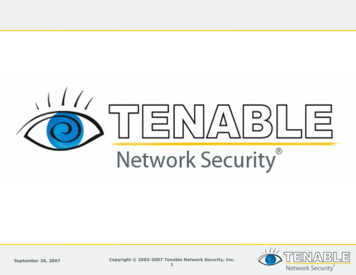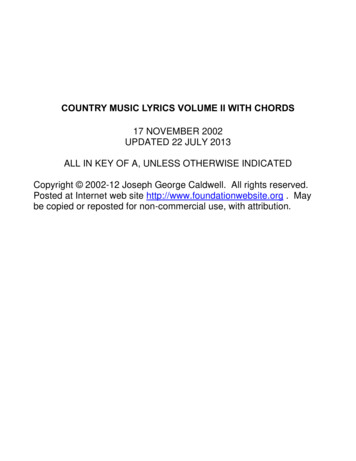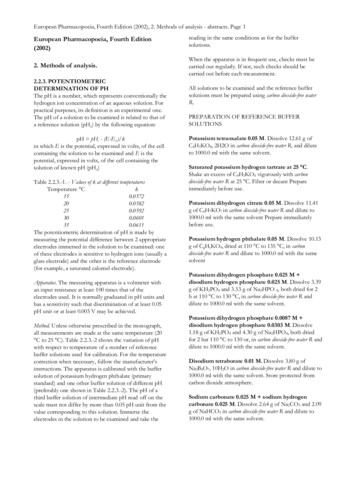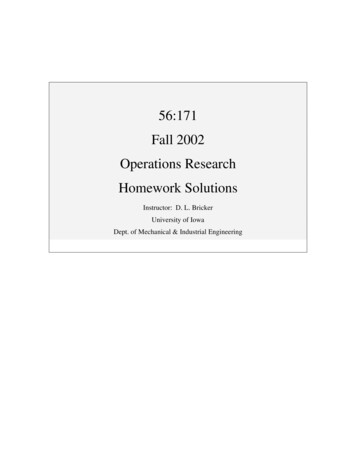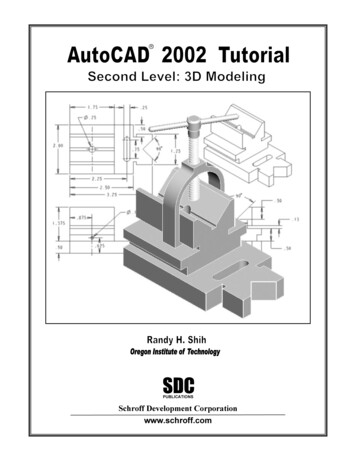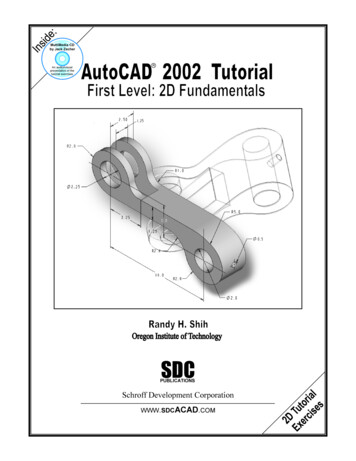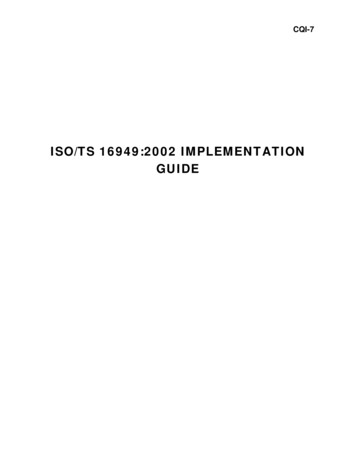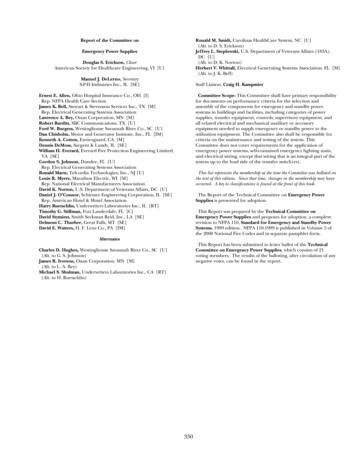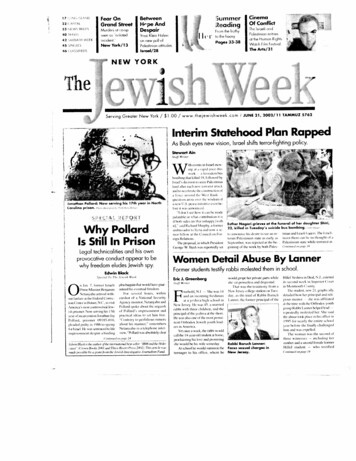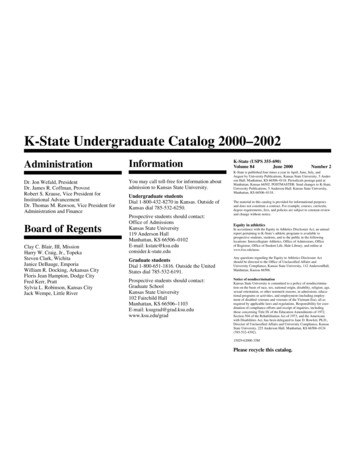
Transcription
Copyright 2002/Updated 20192
The faculty and staff of the Radiologic Technology Program and the Allied Health Departmentwelcome you! It is our desire that you attain the goals that you have set for yourself; thus, wewant to assure you that we are here to help you attain those goals.This document is intended as a reference for you to use during your enrollment in the RadiologicTechnology Program. It contains general information about the program as well as standards thatare specific to students in this program; therefore, it should be used as a supplement to the TCCStudent Handbook and College Catalog.Please read this entire document; you are responsible for the information it contains. You will beasked to sign the last page of this document indication that you have read, understand, and beengiven an opportunity to ask questions about the information. Your signature also denotes thatyou will abide by the policies within the handbook and policies of TCC. Occasionally, it isnecessary to change policies/procedures during the school year. Students will be notified of anychanges to current policies/procedures.3
Dear Applicant,Thank you for your interest in our Radiologic Technology at Tarrant County College. Programinformation and the application to the program can be found at www.tccd.edu , selectCAMPUSES AND CENTERS, Trinity River Campus East, then Radiologic Technology. Pleaseremember that the first Monday in March is the application deadline.College courses taken at other institutions may or may not transfer. Final approval must be givenby the Registrar’s Office at TCC. We recommend that you request a transcript evaluation forthis purpose.In order to insure patient safety and welfare, applicant must have: Visual acuity (with corrective lenses if needed) to identify cyanosis, absence ofrespiratory movement in patients, adverse skin reactions to treatments, read physician’sorders, read very fine print on medication containers, visualize displays on monitors andequipment, and evaluate images for diagnostic quality. Hearing ability (with auditory aids if needed) to understand the normal speaking voicewithout viewing the speaker’s face; hear monitor alarms, emergency signals, call bellsfrom patients, equipment timers and alarms; and take/hear blood pressures. Physical ability to stand for prolonged periods of time, perform cardiopulmonaryresuscitation, transfer patients and objects of 50 pounds or more, perform treatmentprocedures using two hands, push patients and pieces of equipment from room to roomand/or maneuver in limited spaces. Health insurance is required at one or more clinicalsites. The ability to communicate effectively in verbal and written form by speaking clearlyand succinctly when explaining treatment procedures to patients, family members,medical staff, and when describing patient conditions/reactions and implementing healthtechniques. Write legibly and correctly in patient’s records for legal documentation. Sufficient manual dexterity to use aseptic and sterile technique, prepare needles, syringes,contrast media, and manipulate, film, cassettes, and equipment. The ability to function safely under stressful conditions; to adapt to the ever-changingenvironment inherent in clinical situations involving patient care, and to exerciseindependent judgment and discretion in the performance of assigned responsibilities.Allied Health Dept. Policy—2/12/15 “Any student with a documented disability needing academic accommodations is required tocontact the Student Accessibility Resources (SAR) Office to schedule an appointment withthe Coordinator of SAR. The office of SAR is responsible for approving and coordinating alldisability-related services, and all discussions are confidential. Because SARaccommodations may require early planning and are not provided retroactively, students areurged to contact SAR as early in the semester as possible.” Update: 6/154
Acknowledgement:The ARRT Standards of Ethics, ARRT Radiography Clinical Competency Requirements and ARRTRadiography Task Inventory is reprinted by permission of the ARRT.The ARRT Standards of Ethics, ARRT Radiography Clinical Competency Requirements and ARRTRadiography Task Inventory and all parts thereof are copyrighted by the ARRT.5
TABLE OF CONTENTSMission Statement. 7Student HandbookIntroduction. 8Classroom Attendance . 8Class Requirements. 8Clinical Education Courses . 9Clinical Assignments . 9Physical Standards (Clinic) . 10Conduct . 14Accidents . 14Confidential Information . 14Name Tags . 15Dosimeter . 15Policy of Exposure Excess 15Personal Appearance. 16Enrollment Status in Program . 17Re-admittance to Program . 18Clinical Hours . 18Transportation . 19Inclement Weather . 19Pregnancy Policy .20Student Employment Guidelines .21Student Transfer Policy. 21Standards Acknowledgment Signature Page . 22AppendicesAppendix A – Program Glossary . 23Appendix B – TCCD Administrative Policies . 26Appendix C – Links to Professional Regulatory Agencies and Organizations. 33Appendix D – U.S. Nuclear Regulatory Agency – Prenatal Exposure Policy . 35Appendix E - TCC Codes of Behavior/Health Sciences Code of Conduct . 37Appendix F – TCCD Radiography Program Clinical Instructor Job Description . 42Appendix G – Sample of Program Forms. 45FormsClinical Grade Worksheet . 46Clinical Grading System . 47Student Conference Record . 49RADR 1266, 1267, 1366, and 2366 Evaluation Objectives . 50RADR 2367 Evaluation Objectives . 53TCC Report of Student Injury.566
TARRANT COUNTY COLLEGERADIOLOGIC TECHNOLOGY PROGRAMMission StatementTo graduate radiologic technologists who demonstrate clinical competence, professionalism,critical thinking, and communication skills.Program Goals / Student Learning OutcomesI. The student will demonstrate clinical competence.A. Students will correctly apply positioning skills.B. Students will utilize correct exposure technique.II. The student will demonstrate professionalism.A. Students will engage in various professionalism activities.B. Students will model professionalism in the clinical setting.III. The student will demonstrate critical thinking skills.A. Students will employ critical thinking skills to evaluate radiographic images.B. Students will demonstrate critical thinking skills based on patient conditions.IV. The student will demonstrate communication skills.A. Students will communicate effectively based on patient needs.B. Students will exhibit communication skills in the academic environment.Revised/Reviewed: 7/20187
TARRANT COUNTY COLLEGERADIOLOGIC TECHNOLOGYSTUDENT GUIDELINES1.IntroductionThis Student Standards manual has been prepared to set forth the policies, conditions oftraining, and responsibilities for the students of the Tarrant County College (TCC)Radiologic Technology Program.It should be recognized that future changes in medical care practices, standards of hospitalaccreditation, legal, and other social and economic factors may necessitate modificationsand/or amendments from time to time.Students will be responsible for observing college rules and regulations as stated in thecurrent college student handbook, the Radiologic Technology Student Standards, andpolicies applicable at their Clinical Affiliation Assignment. Clinical facilities, whileseparately located, are considered an integral part of the college campus.The Standards as stated represent an agreement between Tarrant County College and theRadiologic Technology students until graduation. Failure to comply with the rulesand regulations will affect student evaluations and will result in dismissal from the program ifthe student shows no improvement or makes no attempt to correct deviations aftercounseling.Program Length and TimeThe TCC Radiologic Technology Program is a 2-year (24 months) Allied Healthprogram. The student’s educational time in the program will be divided between oncampus didactic courses and clinical practicum. The program’s didactic courses andclinical practicum hours do not exceed 40 clock hours of class/clinic time per week.Transfer PolicyStudents wishing to obtain an Associate of Applied Science from TCC who havetransferred into the program must show a completion of 25% of their classes in residencyat TCC (in other words, the classes must be taken at a TCC campus). This is equivalent to16 credit hours for the Radiologic Technology Program. All the 16 credit hours do nothave to be in the radiological sciences.2.Classroom AttendanceThe TCC policy requires punctuality and regular class attendance. TCC does have aMandatory Attendance Policy (view TCC Student Handbook). Students are responsible forall class work covered during absences from class. Attendance will be taken each classperiod. If an absence is foreseen, call your instructor.3.Class Requirementsa.Attendance of class according to TCC policy.b.Preparation for class by reading pertinent references related to the concepts andobjectives designated for the class period.c.Classroom participation.d.Completion of all major examinations.8
e.f.g.4.Comprehensive final examination.Follow specific guidelines set forth by the instructor.Due to the schedule of courses, early program completion is generally not feasible.Late completion (up to 150% of program length from initial acceptance) may bepossible depending upon individual circumstances. Reapplication may be necessary.Students cannot graduate until all TCC/program requirements are completed.Clinical Education CoursesThroughout the Radiologic Technology Program at TCC, the student will attend ClinicalAffiliations in order to:a.Acquire expertise and proficiency in a wide variety of diagnostic radiographicprocedures by applying classroom theory to the actual practice of technical skills onspecified levels of competency.b.Develop and practice professional work habits and appropriate interpersonalrelationships with patients and members of the health care team. Pleaseremember that we are “guests” in the clinic sites.The clinical education courses offered to the student in Radiologic Technology are perhapsthe most important and meaningful activities in which the students are engaged. During thistime, the students will be rotated through different diagnostic areas in order to transferknowledge from theory to application of skills in performing diagnostic radiographicprocedures. Acceptance into the program and clinical sites will require criminalbackground checks, drug screening, health screening, and certain immunizations.Students are responsible for maintaining current records of their immunizations, TB, CPR,influenza, etc., in their Castlebranch account. Students will receive prior notifications fromCastlebranch regarding upcoming requirements. Students will lose 10 professionalismpoints from their clinical grade for failing to maintain current records in Castlebranch bythe deadlines provided. Students who are not current with their Castlebranch requirementswill be required to leave clinic and use clinical absence time to meet the requirements.5.Clinical AssignmentsAll students must be currently certified in CPR, and have their Hepatitis B vaccination andTB test before beginning clinical practice in the Fall Semester of their first year and eachsemester thereafter. Background checks and drug screenings must be performed 30 daysor less prior to clinic start time.The program or clinical coordinator will assign students to the clinical education centers.Students must rotate through at least two centers. Students will also be required to rotatethrough other affiliates during the two years.A clinical instructor will be assigned to each major clinical education center and will beresponsible for student supervision to include scheduling student clinical hours, assignments,and activities. The students will perform clinical practice under the supervision of an ARRT(or eligible) certified and TMB (Texas Medical Board) licensed technologist. When arrivingor departing Clinical Practice without a TCC Clinical Instructor present you must utilizeassigned voice mail and/or the “Record of Clinical Attendance.” All dates and times must beverified by a supervisor’s signature thestudent’s signature. In the event that both your TCC instructor and clinic site employedinstructor are absent: (1) Notify the TCC Clinical Coordinator, Program Coordinator, or anyTCC Clinical Instructor. (2) Continue to perform clinical practice under the supervision ofyour assigned technologist.9
5.1Clinical CompetencyStudents are responsible for timely completion of the ARRT list of radiologic procedures andtask inventory. (Appendix D).SemesterRecommended MinimumRADR 12664RADR 126716RADR 136616RADR 236614RADR 2367All remainingStudents are required to complete a minimum of 36 competencies by the end of RADR 1366or a loss of one letter grade will be deducted from the RADR 1366 clinical grade. Studentsare also required to complete a minimum of 50 competencies by the end of RADR 2366 or aloss of one letter grade will be deducted from the RADR 2366 clinical grade.The minimum number of interim evaluations is two for each semester (excluding the first and“Final Comp.” semesters.) There is no maximum number.Students must demonstrate competency and assure documentation of competency using theattached checklist in accordance with the following guidelines.PROCEDUREMandatory (Radiological)Mandatory (Gen. Patient Care)Mandatory electivesElectiveMINIMUM # REQUIRED3710317P*N*/S*82901021P or N or SElectives should be performed on patients if at all possible. Simulations will be performed atthe discretion of TCCD program faculty. Students must demonstrate competency or theywill receive an "I" for their RADR 2367 grade and will be required to return during thefollowing semester for 30 days to demonstrate competency. Competency demonstration isbased on students meeting the minimum clinical competency requirements and confirmationby program faculty that students have achieved competency.Additional Information:a.Ten to twelve mandatory/elective radiological procedures will be demonstrated duringRADR 1311, RADR 2301, and RADR 2331.b.“Competency demonstration should incorporate patient-specific variations such as ageand pathology.”c.Two of the general patient care competencies, sterile and aseptic technique and care ofpatient medical equipment must be demonstrated during Clinical Practice. The otherfour patient care competencies may be simulated.d.P* actual patient in Clinical Practice; N* phantom/mannequin with actualproduction of radiographs; S* simulated patient (person/phantom/mannequin)without production of radiographs.e.RADR 1366 Practicum – Medical Radiologic TechnologyEvening (1-9:30 p.m.)Student outcome: Demonstrate competency in trauma and other procedures identified amandatory (M) by the ARRT. These procedures are requested at greater frequencyduring evening hours. Approved supervision MUST be available.During the two weeks (8 days) M-Th timeframe, the RADR 1366 student will attemptto:10
5.1e. (cont.)Demonstrate competence in radiologic procedures such as 1) Routine/Trauma Skull/Facial Procedures [i.e., Nasal Bones, Mandible]2) Routine/Trauma Mobile Procedures3) Routine/Trauma Spine/Pelvis4) Procedures Routine/Upper and LowerExtremities5.1f. General GuidelinesWhile performing these imaging procedures, the student will demonstratecompetence by: evaluation of the requisition patient assessment preparation of the exam room patient management equipment operation technique selection positioning skills universal precautions radiation safety imaging processing image evaluation* Dependent on availability of procedures and Trauma level facility5.1g. Rotations through advanced modalities are not guaranteed to any individual.Prior to an advanced modality rotation, the 2nd year student will have completed allprogram requirements, they are:ARRT Procedure Checklist and Task InventoryFinal Competencies including critiqueDemonstrate the ability to “run a room” for 3 clinical days (MWF)No advanced rotation will occur prior to spring break. All rotations through advancedmodalities MUST be submitted in writing to the Clinical Coordinator thr
Program Length and Time The TCC Radiologic Technology Program is a 2-year (24 months) Allied Health program. The student’s educational time in the program will be divided between on- campus didactic courses and clinical practicum. The program’s didactic courses and clinical practicum ho
